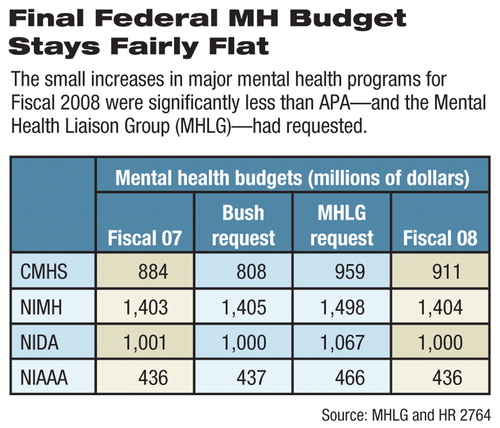Not a Banner Budget Year for Federal MH Funding
Congress provided a small boost to most federal mental health programs under a massive year-end spending measure.
The $555 billion omnibus spending bill (HR 2764), which included funding for the departments of Labor, Health and Human Services (HHS), and Education, would provide far more than President George Bush wanted but less than mental health advocates had hoped.
Part of the reason health care advocates found it “somewhat disappointing” was because Democratic leaders in Congress shaved domestic spending programs after the president vetoed an earlier Labor, HHS, and Education spending bill with higher funding levels, said Lizbet Boroughs, deputy director of APA's Department of Government Relations. Bush vetoed a stand-alone Labor-HHS-Education bill last November that exceeded his spending request by about $10 billion.
The Labor-HHS-Education section of the final measure included $144.8 billion in nonentitlement program spending, about $6 billion less than in the vetoed bill. Much of the reduction came from a 1.75 percent across-the-board spending cut among nondefense domestic programs, which congressional leaders used to come close to meeting Bush's spending ceiling for all discretionary spending other than defense.
Although most of the major mental health programs saw funding increases, including the Substance Abuse and Mental Health Services Administration (SAMHSA), the final dollars were far less than mental health advocates had sought. The measure provided $3.2 billion to SAMHSA, or $27 million more than the previous fiscal year and $188 million more than the administration had requested. However, the Mental Health Liaison Group (MHLG), an advocacy group of more than 50 national organizations including APA, had urged lawmakers to provide much more.
One area in which SAMHSA funding fell short of advocates' goals was the Center for Mental Health Services (CMHS), which received a $27 million boost to $911 million. Advocates had urged a $75 million boost, in part, to expand support of local community mental health agencies' case management, emergency intervention, and 24-hour-hotline programs.
Within CMHS, $7 million was cut from the $428 million provided in Fiscal 2007 for mental health block grants, which provide nearly 40 percent of noninstitutional mental health spending in some states, according to a report by the MHLG.

Suicide-Prevention Cut Reversed
Legislators reversed a $2 million cut sought by the administration for suicide-prevention efforts and instead increased funding by $3 million to $39 million.
However, legislators did cut the only federal program that provides mental health care and evaluates the implementation of new outreach services to the homeless, a third of whom have mental illness. SAMHSA's Projects for Assistance in Transition From Homelessness program was cut by nearly $1 million, to $53.3 million.
Funding for SAMHSA's Center for Substance Abuse Prevention (CSAP) was $194.1 million, or $1.2 million more than the previous fiscal year. That reversed a $37 million, or 19 percent, cut originally sought by the Bush administration.
The final measure made little change in funding for SAMHSA's Center for Substance Abuse Treatment (CSAT) block grant, increasing the $1.7 billion budget by $137,000. Mental health advocates had urged a $180 million boost for the 16-year-old program, which helps expand the types of treatment and recovery services available through alcohol and drug problems.
“Because no single treatment approach is effective for all persons, CSAT supports the nation's effort to provide multiple treatment modalities, evaluate treatment effectiveness, and use evaluation results to enhance treatment and recovery approaches,” according to the MHLG report.
MH Research Gets Small Increase
The final budget provided the National Institutes of Health (NIH) with $29.2 billion, which is about $329 million more than in Fiscal 2007 and nearly $600 million more than Bush originally sought.
The administration had sought cuts or at best minor increases at NIH's three institutes that study mental health—the National Institute of Mental Health (NIMH), National Institute on Drug Abuse (NIDA), and National Institute on Alcohol Abuse and Alcoholism (NIAAA).
The final budget provided NIMH with $1.4 billion, an increase of $2.1 million, or .15 percent. That small increase was ultimately less than the $3 million sought by the administration and significantly less than the $96 million sought by the MHLG.
In testifying about the need for more mental health research funding in the new budget, Thomas Insel, M.D., director of NIMH, said in March 2007 that genomics and imaging expertise are now used to advance the knowledge of serious illnesses such as schizophrenia, depression, bipolar disorder, attention-deficit/hyperactivity disorder, and autism.
“I have every reason to believe that in [Fiscal 2008] research will enhance our understanding of each of these disorders, introducing an era of biomarkers and new treatments that will ultimately reduce the public health burden of these illnesses,” he said.
The institute charged with leading the nation's research in drug abuse and illicit drug use ended up having its funding cut by nearly $1.3 million, to an even $1 billion.
Research aimed at helping the 14 million Americans who meet the medical criteria for a diagnosis of alcohol abuse and alcoholism received a small boost. The budget provided NIAAA with a $674,000 increase, to $436 million. The institute funds 90 percent of U.S. alcohol research “designed to reduce the enormous health, social, and economic consequences caused by abusive drinking,” according to the MHLG.
The MHLG budget report can be accessed at<www.mhlg.org/page5.html>.▪



